Gluing leather to wood can be a great way to create unique and attractive projects. Whether you’re making an upholstered headboard, crafting a wooden box with leather trim, or making something entirely different, the process of gluing leather to wood is relatively simple. But it’s important to make sure you use the right kind of glue so that your project will have a lasting bond. In this article, we’ll discuss how to glue leather to wood and answer some of the most common questions about this process. We’ll also provide some useful tips so that you can be assured your project will look great and last for years to come!
Can you use wood glue for leather?
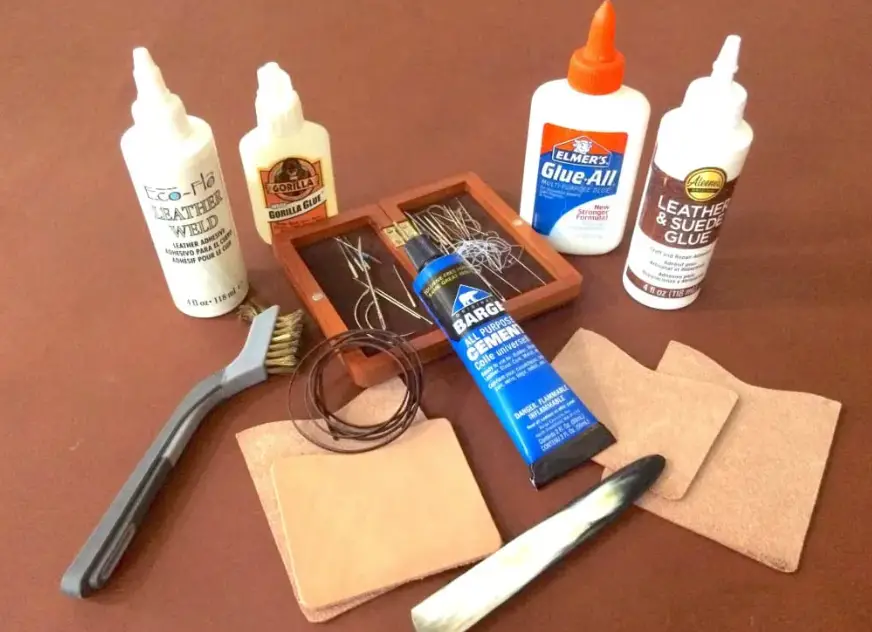
The short answer is no, you cannot use wood glue for leather. Wood glue, or PVA (polyvinyl acetate) glue, is designed to bond to porous materials like wood and paper. It does not form a strong enough bond on leather and will eventually break down when exposed to moisture or heat. If you want your project to last, you’ll need to use a specialized glue that’s designed specifically for gluing leather.[2]
Types of glue
Permanent Glue
The most suitable glue for gluing leather to wood is a permanent adhesive that will form a strong bond and is water-resistant. Epoxy, polyurethane glue, contact cement, hide glue, and hot glue are all good options. However, make sure you read the directions on the product label before using it to ensure it is safe for use with leather.[1]
Temporary Glue
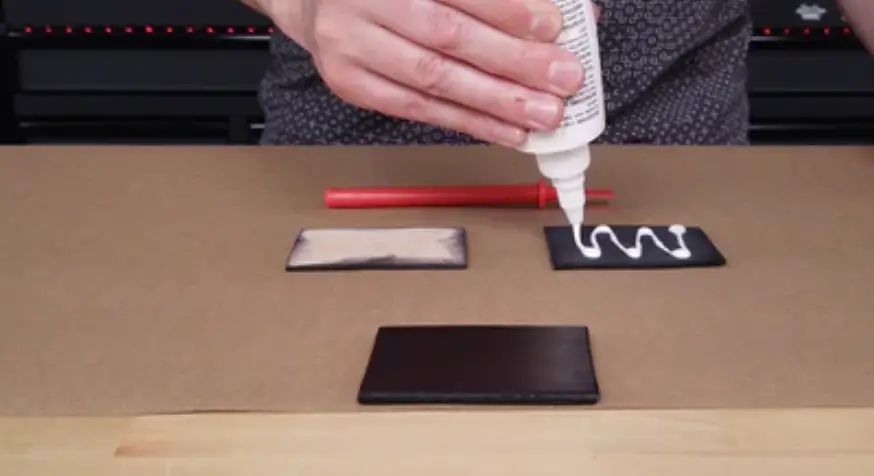
If you only need to attach the leather temporarily, you may want to use a removable glue. This type of glue is ideal for craft projects or when you’re not sure how long an item will need to be attached. Common removable glues include rubber cement, white glue, and spray adhesive.[1]
Contact Cement
One of the best options for gluing leather to wood is contact cement. This type of glue creates a strong bond between two surfaces and forms an instant connection when applied. It’s important to note that contact cement can be difficult to work with, so make sure you read the directions carefully before using it.[1]
Epoxy glues
Epoxy glues are a popular option for gluing leather to wood. These glues provide excellent adhesion and can be used for indoor or outdoor projects. When using epoxy, make sure you apply the adhesive evenly on both surfaces so that they bond together properly.[1]
Polyurethane Glue
Polyurethane glue is also a great option for gluing leather to wood. This versatile adhesive can be used on a variety of materials and provides excellent adhesion, even when exposed to moisture. It’s important to read the label carefully before using this type of glue to make sure it is safe for use with leather.[1]
Polyvinyl Acetate (PVA)
Polyvinyl acetate, or PVA, is another good option for gluing leather to wood. This type of glue creates an instant bond and dries clear. It’s important to note that PVA can be heavy-duty, so make sure you read the directions carefully before use.[1]
How to Glue Leather to Wood?

Prepare both Surfaces
Before you start to glue leather to wood, you must first prepare both surfaces. Make sure the surfaces are free of dust and dirt by wiping them down with a cloth. If there is any residue on either surface, use a solvent like rubbing alcohol or acetone to remove it. Once you’ve ensured that the surface is clean, let it dry thoroughly before proceeding.[4]
Choose the Right Adhesive
Finding the right adhesive is an important step in successfully gluing leather to wood. Choose a product that specifically mentions it can be used for leather and wood adhesion, such as contact cement or neoprene rubber adhesive. Make sure you read all of the instructions on the glue before using it.[4]
Rub on the Contact Cement
Once you’ve chosen the right adhesive, you can begin to glue leather to wood. Rub some contact cement on both surfaces with a cloth or brush. Be sure not to apply too much; just enough so that a thin layer is covering the entire surface. Then let the cement dry for a few minutes.[4]
Adhere the Materials
Once the contact cement has dried, you can adhere the two materials together. Place one surface on top of the other and press firmly to make sure they’re stuck together. You may need to use a roller or press to ensure a strong bond. Make sure that you press evenly over the entire surface for best results. Once you’ve finished pressing, leave the materials to dry.[4]
Smooth the Leather and Trim Excesses
Once the leather and wood have dried, you’ll need to smooth out any wrinkles or bumps on the leather. Use a tool such as a sponge or brush to do this. You can also trim off any excess material, if necessary.[4]
Provide an Added Protection Using an Acrylic Sealant
To help the glue bond last longer, you can apply an acrylic sealant on top. This will provide additional protection against water and other elements. Simply spray or brush a thin layer of sealant over the glued area and let it dry for 24 hours before using the item.[4]
What is the best glue for leather on wood?
The best glue for leather on wood is a flexible adhesive, such as a specialized leather glue or a two-part epoxy resin. Such an adhesive will provide the best bond strength while allowing some flexibility and movement between the leather and the wood. In cases where more flexibility is needed, contact cement may be used.
However, it should be noted that contact cement does not provide the same strength as the specialized leather glues and two-part epoxy resins.
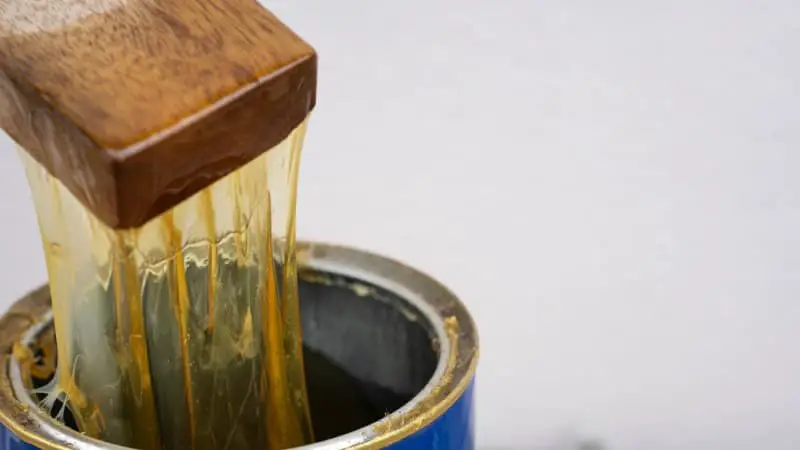
When selecting a glue for bonding leather to wood, pay close attention to its curing time and drying time. For instance, some two-part epoxy resins may require several hours or even days to cure properly.[2]
Can a hot glue gun glue wood and leather together?
Yes, a hot glue gun can be used to bond wood and leather together. However, it may not provide the strongest or most permanent bond. Hot glue guns are often used for quick repairs, but they may not hold up to long-term wear and tear. It’s also important to make sure you’re using the right kind of glue stick. For best results, use a high-temperature glue stick that is specifically designed for bonding wood and leather together.
Additionally, you should make sure you’re gluing the leather onto a smooth surface. If there are any imperfections or jagged edges on the wood surface, it could weaken the bond of your hot glue gun. Before applying the glue, use sandpaper to smooth out any rough patches.
Overall, a hot glue gun is an effective way to glue leather onto wood if you need a quick fix. However, for best results and the strongest bond, it’s better to use a specialized leather adhesive. This type of adhesive provides a stronger connection that will last longer and create a more permanent result.[3]
Is Super Glue good for gluing leather to wood?
Super glue is a type of adhesive that works on many materials, including leather and wood. It’s not always the best choice for gluing leather to wood though, as it can work too quickly and cause the material to buckle or wrinkle if you’re not careful.
Additionally, make sure to work quickly and precisely to prevent any unwanted buckling or wrinkling.[3]
What kind of glue will glue leather to wood?
The type of glue you use to adhere leather and wood depends on several factors, including the type of leather and the intended purpose for the bonded item. If you want a strong bond that will last, an industrial-grade adhesive such as contact cement or hide glue may be your best option. However, if you’re looking for something less permanent or need a specific color to match the leather and wood, there are many other types of glues available.
For instance, if you need an adhesive that will hold up against high temperatures, a rubber-based cement may be more suitable than traditional white glue. Similarly, if you want an invisible bond or a fast-drying adhesive for small projects.[3]
FAQ
How do you glue down leather?
The most important part of gluing leather to wood is making sure the surfaces are clean and free from dirt, oil and other debris. To apply glue, start by spreading a thin layer on one surface with a brush or roller. Then press the two pieces together firmly for about 30 seconds before releasing them. Allow the glue to dry and cure completely before using the item.
How do you glue faux leather to plywood?
When gluing faux leather to plywood, start by cleaning both surfaces and ensuring they are free from dirt, oil and other debris. Then apply an adhesive such as hot glue or contact cement to one surface and spread it evenly with a brush or roller. Press the two pieces together firmly for 30 seconds before releasing them. Allow the glue to dry completely before using the item.
What glues leather to wood?
There are several types of glue you can use to bond leather to wood, including contact cement, hot glue and epoxy. It’s important to choose the right glue for the job. For instance, contact cement works best when gluing large pieces together or bonding multiple layers of leather together. Hot glue works well for small items and is particularly effective when gluing faux.
What is the best glue for leather and wood?
The best glue for leather and wood depends on the type of application. For larger items such as furniture, contact cement is often the preferred option. Hot glue works well for smaller items such as wallets, bags and purses, while epoxy can be used to bond multiple layers of leather together or attach metal hardware. Test a small area before committing to using any particular glue.
Can you glue leather with a glue gun?
Yes, you can glue leather with a glue gun. It’s important to select the right type of glue for the job; a specialty adhesive designed specifically for leather is recommended. Apply the hot glue in short bursts and press the pieces together firmly before allowing them to cool. This will ensure that the bond is strong and long-lasting.
What glue is best for faux leather?
Hot glue is the best choice for gluing faux leather as it provides a strong bond and sets quickly. Other options include contact cement, which works well on larger pieces, or epoxy, which can be used to attach metal hardware to faux leather. As with all adhesives, test a small area first before committing to using any particular product.
Can you use fabric glue on leather?
Yes, fabric glue can be used on leather. However, it is important to use a product specifically designed for leather as other adhesives may not provide a strong enough bond or may adversely affect the leather’s appearance. Test a small area first before committing to using any particular product.
Useful Video: The Leather Element: Leather Glue Overview
Conclusion
Leather is a great material to use when gluing it to wood for various craft projects. From a simple piece of tooling leather to an elaborate handmade bag, the possibilities are endless. Even though it can be difficult to get the right bond between leather and wood, it’s not impossible. With the right materials and techniques, you can successfully glue leather to wood and create something truly unique. Remember to always test the bond on a scrap piece of leather before committing to your project, be sure to use the right glue for the job, and to take your time when gluing leather to wood. With patience and practice, you can craft beautiful pieces with leather and wood.
If you have any questions or concerns about how to glue leather to wood, be sure to consult with a professional. Good luck and happy gluing!
Thank you for reading our article on How to Glue Leather to Wood.
References
- https://leatheradvice.com/how-to-glue-leather-to-wood/
- https://gluecare.com/glue-leather-to-wood/
- https://leatherinsights.com/how-to-glue-leather-to-wood/
- https://leatherninja.com/how-to-glue-leather-to-wood/



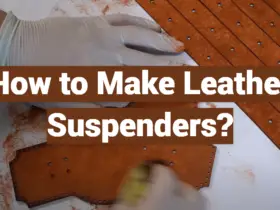

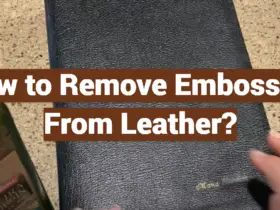

Leave a Reply